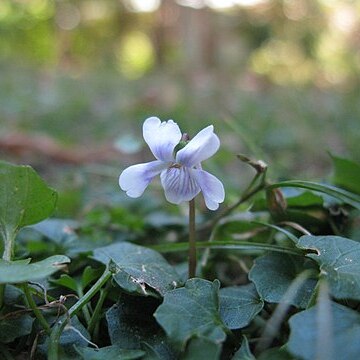Herbs perennial, stoloniferous. Stem erect, short. Leaves clustered; stipules linear-lanceolate, 1.5-8 mm, margin glandular-denticulate; petiole 0.5-6 cm, sometimes to 12 cm; leaf blade ovate, reniform, or suborbicular, glabrous or puberulous, base cuneate, truncate, or slightly cordate, margin entire to large repand or crenate. Flowers with scape to 10 cm high, glabrous or puberulous, bracteolate near middle. Flowers 3-10 mm in diam., sometimes to 15 mm, scentless or faintly scented. Sepals green, ovate to linear-lanceolate, 1.5-5 mm, glabrous or sparsely puberulous, basal appendages short. Petals white or pale to dark violet, 2-10 mm, anterior one shallowly saccate, spurless, lateral ones somewhat falcate, bearded inside or glabrous. Stamens to 2 mm; filaments 0-0.3 mm. Capsule ovoid, 4-6 mm. Seeds white, brown, or black, ovoid, 1.5-2 mm. Fl. Feb-Apr, fr. May-Sep.
Perennial herb; stems contracted, erect; stolons well-developed. Leaves tufted, glabrous or with scattered hairs above; lamina reniform to semicircular or rhomboid, 3–35 mm long, 5–50 mm wide, apex obtuse, margins entire to scalloped or broadly toothed, base broadly cordate, truncate or somewhat cuneate; petiole mostly 2–8 cm long; stipules free, linear-lanceolate, 2–5 (–8) mm long, glandular-denticulate. Flower-scapes 3–17 cm long; bracteoles near middle. Sepals lanceolate, 2.5–6 mm long, acute, basal appendages small. Petals 5–10 (–12) mm long, 2-coloured, mauve-violet near base, grading to white in upper third; anterior petal obovate, mostly 5–7 mm wide, usually emarginate, without a spur; lateral petals entire, twisted through to c. 90 degrees, bearded. Capsule ovoid, 4–6 mm long. Seeds ovoid, 1.2–2 mm long, dull, cream, brown or black, often mottled.
Rhizomatous and stoloniferous perennial; stolons arching, glabrous, producing offset plants 80-200 mm from rosette. Lvs all rosulate, hairy above and beneath, 15-30 × 12-25 mm, broadly reniform, obtuse, with 5-9 blunt teeth each side; stipules linear, glandular-fimbriate, 3-6 mm long; petiole 3-6 cm long, with patent hairs. Peduncles erect, glabrous; bracts linear, bluntly glandular-dentate, 5-8 mm long. Fls c. 2 cm diam. Sepals linear-lanceolate, acute, 5-6 mm long; appendages 0.5 mm long. Petals white, mauve at base, exceeding sepals, the lateral bearded, the anterior veined and saccate but not spurred. Style geniculate at base, 2.5 mm long; stigma not beaked. Capsule ovoid, glabrous, 4-6 mm long. Seeds ovoid, brown or black, 1.5-2 mm long.
A low creeping plant. It grows 5-8 cm high. It spreads 1-2 m wide. It spreads by runners. These produce roots at the nodes. The leaves are like ivy. They are round to kidney shaped and dark green. They are scalloped along the edge. The flowers are purple and white violets and on long stems. The fruit are egg shaped.

